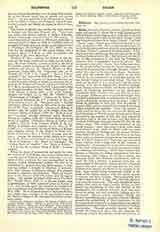

Kilian (KILLENA, CILLINE), Saint, Apostle of Franconia and martyr, b. about 640 of noble parents probably in Ireland (according to others in Scotland, though Scottica tellus, as it is called by the elder “Passio”, may also in medieval times have meant Ireland. The later “Passio” says: “Scotia quae et Hibernia dicitur”); d. July 8, probably in 689. He was distinguished from his youth for his piety and love of study, and, according to the later “Passio”, embraced the monastic life. Trithemius and later writers say that he was a monk in the celebrated monastery of Hy: that he was later the abbot of this monastery is also held by Trithemius; however, that, a supposition, cannot be proved. The statement in the older “Passio” that Kilian was raised to the purple before leaving his native land may be accepted as trustworthy, although the later “Passio” refers this event to his sojourn in Rome. In accordance with the custom then prevailing in the Irish Church, he was assigned to no particular diocese, but was district bishop or traveling bishop. One day he made up his mind to be a missionary, left his native country with eleven companions, traveled through Gaul, thence across the Rhine, and finally reached the castle of Wurzburg, inhabited by the Thuringian (Frankish) Duke Gozbert, who was, like his people, still pagan. Kilian resolved to preach the Gospel here, but first journeyed with his companions to Rome to receive missionary faculties from the pope. John V, whom he expected to find, had died meanwhile (August 2, 686), and was succeeded by Conon from whom Kilian obtained his faculties. From the sources already cited, we learn that the arrival of St. Kilian and his companions at Wurzburg and the journey to Rome occurred in the summer of 686, that they arrived in the latter city in the late autumn, and that their labors at Wurzburg continued during 687 and the following years. The original group separated on the return journey—some departing to seek other fields of missionary work, while St. Kilian with two companions, the priest Coloman and the deacon Totnan, came back to Wurzburg. He took this town as the base of his activity, which extended over an ever-increasing area in East Franconia and Thuringia, and converted Duke Gozbert with a large part of his subjects to Christianity. Concerning the cause of the martyrdom of the three missionaries, the early documents supply the following information: After Duke Gozbert had become a Christian, St. Kilian explained to him that his marriage with Geilana, his brother’s widow, was unlawful under the Christian dispensation, and se-cured the duke’s promise to separate from her. In consequence of this action, Geilana plotted vengeance against the saint, and caused him and his two companions to be secretly murdered in the absence of the duke, their corpses being immediately buried at the scene of the crime together with the sacred vessels, vestments, and holy writings. This is generally held to have happened on July 8, 689, although opinions vary as to the exact year. The early documents relate further that, after the duke’s return, Geilana at first denied any knowledge of what had become of the missionaries; the murderer, however, went mad, confessed his crime, and died miserably, Geilana also dying insane. Recent critics, especially Hauck and Riezler (see bibliography), question without sufficient grounds the authenticity of these statements in the matter of detail, especially as regards the cause and the immediate circumstances of the martyrdom of the three missionaries. Through prejudice against the Irish Church the Protestant party has also disputed the absolutely reliable information about the journey to Rome undertaken by St. Kilian and his assistants. His missionary labors through Eastern Franconia and his martyrdom are, however, accepted without question by everyone. Although Kilian’s work was not continued after his death, St. Boniface on his arrival in Thuringia found at least evidence of his predecessor’s influence. The relics of the three martyrs, after wonderful cures had brought renown to their burial place, were transferred in 743 by Saint Burchard, first Bishop of Wurzburg, to the Church of Our Lady, where they were temporarily interred. Later, when Bur-chard had obtained Pope Zachary’s permission for their public veneration, they were solemnly transferred—probably on July 8, 752—to the newly finished Cathedral of the Savior. Still later they were buried in St. Kilian’s vault in the new cathedral erected on the spot where tradition affirms the martyrdom to have taken place. The New Testament belonging to St. Kilian was preserved among the treasures of Wurzburg Cathedral until 1803, and since then has been in the university library. Kilian is the patron saint of the diocese, and his feast is celebrated in Wurzburg on July 8 with great solemnity.
The chief source of information is the older and shorter “Passio” (which begins “Fuit vir vitae venerabilis Killena nomine”), formerly considered to date from the tenth or ninth century. Emmerich (after the example of the “Histoire litteraire de la France“, IV, Paris, 1738, p. 86), and Hefner (see below) on very good grounds now connect the appearance of this chronicle with the solemn translation of the relics in 752, which raises its historic value beyond the reach of attack. The later and more voluminous “Passio” is an amplified and embellished version of the earlier one and cannot be relied upon when the accounts differ. Both have been published by H. Canisius, “Antiquae lectiones”, IV, pt. ii (Ingolstadt, 1603), pp. 625-47; by Mabillon, “Acta Sanctorum O.S.B.”, II (Paris, 1669), p. 991-3; in the “Acta Sanctorum” for July 8 (see below), and finally, with a collection of later sources and with the office of St. Kilian of the Wurzburg Church, by Emmerich (see below).
FRIEDRICII LAIICHERT

